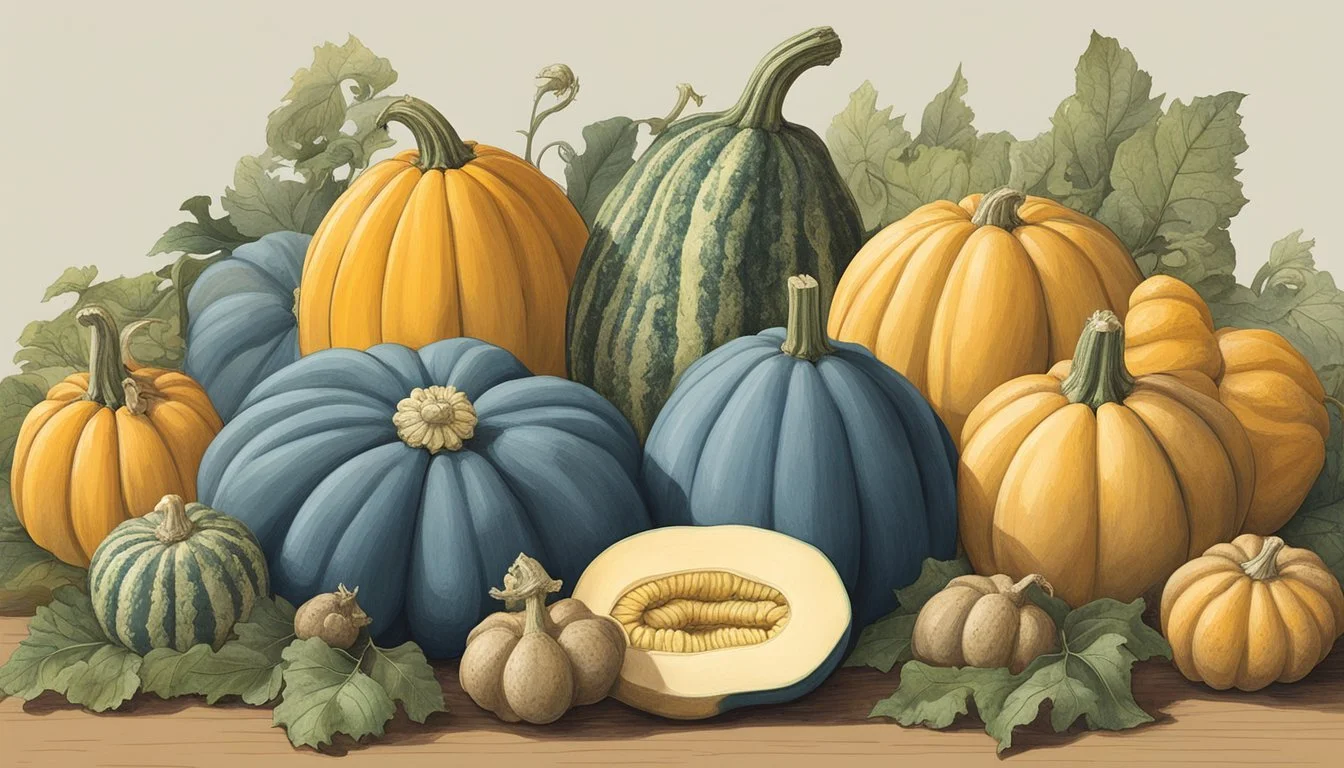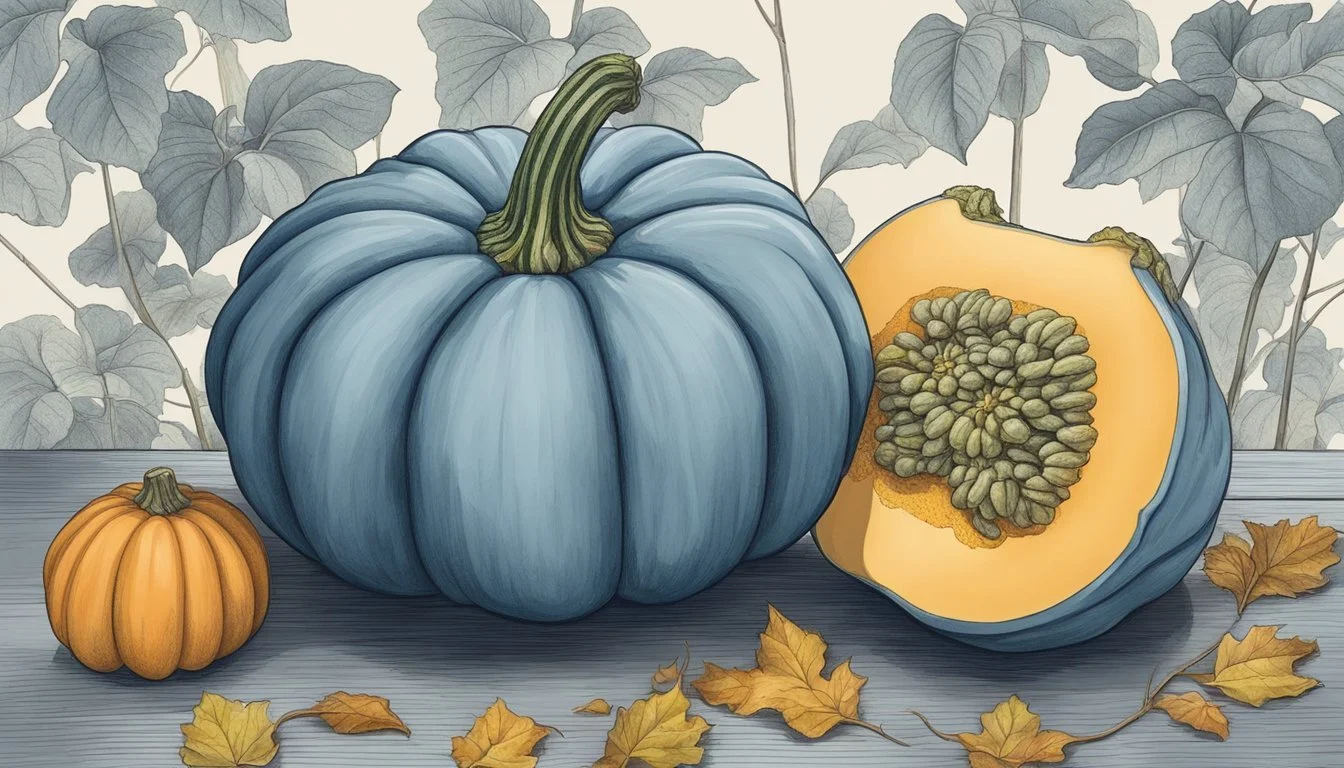Blue Hubbard Squash Substitutes
Top Alternatives for Your Recipes
When it comes to finding a suitable substitute for Blue Hubbard squash, there are several excellent options that can deliver similar flavors and textures in your recipes. Kabocha squash stands out as a top choice, offering a sweet taste and dense, starchy flesh similar to Blue Hubbard. Its rich, nutty flavor makes it an appealing alternative in soups, stews, and roasted dishes.
Another versatile substitute is Butternut squash, which provides a slightly sweeter and creamier texture. Its smooth flesh and easy-to-peel skin make it a convenient option for a variety of culinary uses, from purees to casseroles. Acorn squash, with its mildly sweet and slightly fibrous flesh, also serves as an effective replacement, particularly in baked dishes and stuffed recipes.
Don’t overlook the potential of Sugar pumpkins, which can mimic the consistency and taste of Blue Hubbard squash in both savory and sweet preparations. Each of these alternatives ensures that your dishes remain flavorful and satisfying, even when Blue Hubbard squash is unavailable.
Understanding Blue Hubbard Squash
Blue Hubbard squash is a popular winter squash known for its large size, thick skin, and nutrient-rich flesh. This section will explore its key characteristics, culinary applications, and nutritional benefits.
Characteristics of Blue Hubbard Squash
Blue Hubbard squash typically weighs between 5 to 15 pounds and has a distinctive bumpy, blue-gray skin. The skin is tough and needs to be cut with care. Inside, the flesh is bright orange and has a dense, smooth texture. The seeds can be roasted like pumpkin seeds.
When selecting a Hubbard squash, look for one that is heavy for its size with a matte skin, indicating ripeness.
Culinary Uses of Blue Hubbard Squash
Blue Hubbard squash is versatile in the kitchen. It can be roasted, mashed, or used in soups and purees. Prepping involves removing the seeds and baking or steaming the flesh. For roasting, the flesh can be cubed, seasoned with herbs and spices, and baked at 350°F until tender.
Mashed Blue Hubbard squash can be mixed with ghee, salt, pepper, and coconut milk for added creaminess.
Nutritional Profile of Blue Hubbard Squash
Nutritionally, Blue Hubbard squash is rich in Vitamin A and Vitamin C, offering a boost to the immune system and skin health. It provides dietary fiber, which aids digestion. The flesh is also low in calories, making it a suitable addition to various diets.
Other nutrients present include potassium, which supports heart health, and beta-carotene, known for its antioxidant properties. This makes Blue Hubbard squash a nutritious and beneficial component of a balanced diet.
Selecting and Preparing Blue Hubbard Squash
Selecting a ripe Blue Hubbard squash and properly preparing it for cooking are essential steps to enjoy its unique flavor and texture. The following subtopics provide specific guidance to ensure your squash is perfect and ready for any recipe.
How to Choose the Perfect Squash
When selecting a Blue Hubbard squash, look for one that is heavy for its size. This indicates a good water content and density. The skin should be a dull, matte color, as a shiny skin can suggest it was picked too early.
Check for blemish-free skin without any soft spots, which could indicate rot. A ripe squash will have a hard, tough skin that is difficult to pierce with a fingernail. Avoid squashes that have been sitting for too long and show signs of mold or discoloration.
Preparing Squash for Cooking
To prepare a Blue Hubbard squash for cooking, start by thoroughly washing the exterior to remove any dirt. Use a sharp knife to cut a small slit into the squash. Rock the knife gently back and forth to crack the tough skin, then cut it in half lengthwise.
Scoop out the seeds and pulp with a spoon. Seeds can be saved and roasted for a crunchy snack. Cut the squash halves into smaller pieces if needed. Depending on the recipe, the flesh can be cubed or sliced. Remove the skin using a paring knife if required.
Brush the flesh with olive oil or melted butter before cooking to enhance flavor and prevent drying out. Prepare as desired, whether you are baking, roasting, or boiling.
Primary Cooking Techniques
Blue Hubbard squash can be prepared using a variety of cooking methods. Some of the most common techniques include baking and roasting, boiling and steaming, and sautéing and mashing.
Baking and Roasting Blue Hubbard Squash
To bake or roast Blue Hubbard squash, start by preheating the oven to 400°F (200°C). Cut the squash in half lengthwise using a sturdy knife, and scoop out the seeds and stringy pulp with a spoon.
Brush the cut sides of the squash with olive oil and sprinkle with salt and pepper. Place the halves cut side down on a baking sheet lined with parchment paper. Roast in the preheated oven for 45-60 minutes, or until the flesh is fork-tender.
For smaller pieces, cut the squash into cubes and season with herbs. Cover these with foil to retain moisture and roast for 30-45 minutes, stirring occasionally.
Boiling and Steaming
Boiling and steaming are effective methods to achieve tender Blue Hubbard squash. Peel and cut the squash into cubes. For boiling, place the cubes in a large pot of boiling salted water and cook for 10-15 minutes until fork-tender.
For steaming, place the cubes in a steaming basket over simmering water. Cover the pot and steam for about 15-20 minutes. Both methods preserve the squash's nutrients and are ideal for making purees or mashing.
When boiled or steamed, mash the squash with a potato masher or fork, adding a little butter or olive oil for creaminess.
Sautéing and Mashing
Sautéing Blue Hubbard squash can bring out a delightful depth of flavor. Begin by peeling and cutting the squash into bite-sized pieces. Heat a skillet over medium heat and add a couple of tablespoons of olive oil.
Add the squash to the skillet and sauté for about 10-15 minutes, stirring frequently, until the pieces are tender and slightly caramelized. You can season the squash with herbs and spices like garlic, rosemary, or thyme.
For mashing, cook the squash by boiling or steaming first, then transfer to a bowl and mash with a fork or potato masher. Add butter, olive oil, or even a bit of cream for a smooth texture.
Seasoning and Flavoring
Seasoning Blue Hubbard squash enhances its naturally sweet and nutty flavor. Balancing sweet, salty, and savory elements helps to create a delightful and well-rounded taste.
Herbs, Spices, and Sweeteners
Several herbs and spices complement Blue Hubbard squash. Garlic and pepper add depth, while cinnamon and nutmeg bring out its sweetness. Adding brown sugar or maple syrup can enhance the squash's natural sugary undertones.
For a savory touch, try adding salt and a mix of spices like rosemary, thyme, or sage. These seasonings pair well with the creamy texture of the squash and provide a balanced flavor profile. Experimenting with different combinations can yield delicious results.
Creating a Balance of Flavors
Achieving a harmonious balance of flavors is key. Start by using butter or olive oil to sauté garlic for a rich base. Sprinkle with a pinch of salt and pepper for taste.
To balance sweetness, add a touch of brown sugar or maple syrup. These ingredients should be used sparingly so they do not overpower the dish. Combining savory herbs with sweet elements creates a sophisticated flavor experience.
Blue Hubbard Squash Recipes
Blue Hubbard squash is a versatile vegetable that can be used in a variety of recipes, from savory soups and stews to delectable desserts and side dishes. Its natural sweetness and nutty flavor make it an ideal ingredient for many delicious creations.
Soups and Stews with Blue Hubbard Squash
Blue Hubbard squash is perfect for making hearty soups and stews. It can be roasted to bring out its flavors, then blended into a smooth purée for a comforting squash soup. Spicy Blue Hubbard Squash Soup combines roasted squash, cumin, chili powder, leeks, and coriander for a tantalizing dish.
For a chunky option, try Blue Hubbard Squash and White Bean Soup, which uses both pureed and oven-roasted squash, tender white beans, garlic, sage, and parmesan. Another option is to add Blue Hubbard squash to traditional stews for added sweetness and depth.
Desserts and Baked Goods
Blue Hubbard squash’s natural sweetness makes it an excellent choice for desserts and baked goods. It can be pureed and used in pies, similar to pumpkin or sweet potato pie. Squash Muffins are another great option, blending squash purée with spices like cinnamon, nutmeg, and cloves.
Adding Blue Hubbard squash to cakes and quick breads can enhance their moisture and flavor. It can also be used in custards and puddings for a unique twist on classic desserts, offering a subtle sweetness and creamy texture.
Side Dishes Featuring Blue Hubbard Squash
As a side dish, Blue Hubbard squash can be prepared in various ways. It can be roasted with olive oil, salt, and pepper for a simple yet delicious accompaniment to any meal. For a more elaborate dish, consider a Blue Hubbard Squash Casserole with breadcrumbs and cheese.
Another option is to steam the squash and serve it with a butter and herb blend. Squash purée can also be served as a side, seasoned with brown sugar or maple syrup for a sweet touch. This versatile vegetable can even be stuffed with grains and vegetables for a hearty vegetarian side.
Suitable Substitutes for Blue Hubbard Squash
When Blue Hubbard squash is unavailable, various substitutes can replicate its texture and flavor. Some of these alternatives include similar varieties like butternut and acorn squash, as well as other versatile ingredients such as sweet potatoes and pumpkins.
Similar Varieties for Substitution
Butternut Squash
Butternut squash stands out as a top replacement. Its creamy texture and sweet flavor closely mimic Blue Hubbard squash. Ideal for roasting or pureeing, it also complements soups and stews effortlessly.
Acorn Squash
Acorn squash is another excellent alternative. It offers a slightly nutty taste and can be used in many dishes that call for Blue Hubbard. Due to its small size, it is easy to handle and prepare in both wedges and purees.
Pumpkin
Pumpkin can also serve as an effective substitute. Its rich, earthy flavor and fibrous texture make it suitable for roasting. It’s a versatile ingredient, great in both savory and sweet dishes, including soups and casseroles.
Other Substitute Recommendations
Sweet Potato
Sweet potatoes make an excellent substitute. Similar in color and sweetness to Blue Hubbard, they work well in various dishes. Whether roasted, mashed, or included in stews, sweet potatoes offer both flavor and nutritional benefits, providing fiber and essential vitamins.
Sugar Pie Pumpkin
Sugar pie pumpkins are another substitute. They are sweet and dense, making them perfect for baking and roasting. These pumpkins work well in both savory dishes and desserts.
Buttercup Squash
Buttercup squash offers a rich, sweet flavor. It has a denser texture, making it suitable for hearty dishes. It can be roasted or used in purees to add a creamy consistency to any recipe.
Utilizing these substitutes ensures that recipes maintain their intended flavor and texture, even when Blue Hubbard squash is not available in the market. The versatility of these ingredients also allows for healthy and creative culinary experiments.








